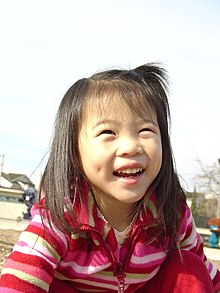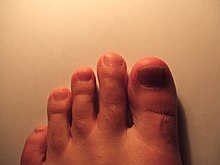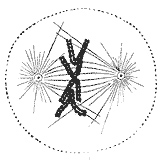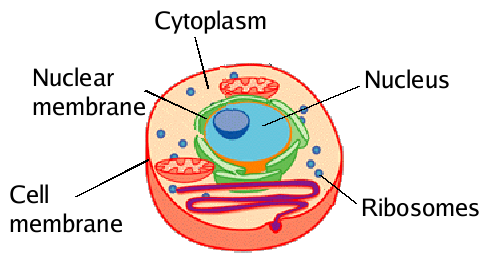Adventist Youth Honors Answer Book/Health and Science/Heredity
| Heredity | ||
|---|---|---|
| Health and Science North American Division |
Skill Level 3 | 
|
| Year of Introduction: 2004 | ||
|
The Heredity Honor is a component of the Health Master Award . |
1. What is meant by the term "heredity"?[edit | edit source]
Heredity refers to the transfer of biological characteristics from a parent organism to offspring, and is practically a synonym for genetics, as genes are now recognized as the carriers of biological information.
A simpler way to describe "heredity" is simply how traits are passed on from parent to offspring.
2. Draw a picture of an animal cell and label the following parts: Cell membrane, cytoplasm, nucleus, nuclear membrane, golgi bodies, ribosomes.[edit | edit source]
3A. What is a chromosome and where are they located?[edit | edit source]
A chromosone is a threadlike linear strand of DNA and associated proteins in the nucleus of eukaryotic cells that carries the genes and functions in the transmission of hereditary information. Chromosomes are located in the nucleus.
3B. What is a gene and where is it found?[edit | edit source]
It is a segment of a chromosome responsible for a trait,it is also a piece of DNA with specific sequence which is responsible for a phenotype and any change (mutation) in the sequence results in respective change in the phenotype, and it is a sequence of DNA that contains the information for ("Codes for") the construction of a protein (genotype).Genes are located on the chromosomes.
4A. What is meant by the term "allele"?[edit | edit source]
An allele is any one of a number of viable DNA codings of the same gene occupying a given position on a chromosome. Humans have paired chromosomes in their somatic cells, and these contain two copies of each gene. In some cases the two copies of the gene are identical — that is, have the same allele. In other cases, the two copies are different. Humans inherit two copies of every gene, one copy comes from the mother, and the other comes from the father.
4B. How does a dominant allele differ from a recessive allele?[edit | edit source]
Characteristics associated with a certain allele can sometimes be dominant or recessive, but often they are neither. A dominant trait will be expressed when at least one allele of its associated type is present, whereas a recessive trait will be expressed only when both alleles are of its associated type.
4C. Determine which allele you have of the following genetic traits[edit | edit source]

- Widow's Peak
- A widow's peak is a descending V-shaped point in the middle of the hairline (above the forehead). The trait is inherited genetically and dominant. The term comes from English folklore, where it was believed that this hair formation was a sign of a woman who would outlive her husband.

- Free earlobe
- The free earlobe is a dominant trait, and its counterpart, the attached earlobe, is recessive. Geneticists are unsure if it is the result of a single gene or if multiple genes are involved.

- Dimples
- Dimples are small indentations in the cheeks most evident when a person possessing this trait smiles.
- Curved thumb
- Giving the "hitchhikers thumb" the end section of the thumb where the thumbnail is located is not 90 degrees straight up and down with the rest of the thumb. It points farther backwards than 90 degrees. It is a commonly dominant trait.
- Bent pinky
- Holding your hand up in front of you, palm outwards, fingers extended you will notice that your pinky finger may or may not bend towards your ring finger.
- Digit hair
- Digits refer to your fingers and toes. Dominant traits possess hair (even if it is very fine hair) on the section of the digit closest to the body or foot. Recessive traits have no hair.
- Rolling tongue
- It was once taught with certainty that the ability to roll one's tongue into the shape of a tube was a dominant trait, however; based on the research data kept by Genome Research, this may not be the case. In 1952 Matlock and again in 1975 Martin realized that identical twins are no more likely to be able to roll their tongues than are fraternal twins. From the evidence, it appears that the ability to roll one's tongue may not be a genetic trait after all.

- Second toe longer
- Morton's toe is the common term for the second toe (second from innermost) extending further than the great toe (Hallux). Morton's toe is typically due to a lengthened second metatarsal. The Metatarsus is the five long bones of the foot. Although commonly described as a disorder, it is sufficiently common to be considered a normal variant of foot shape (around 10% of feet worldwide have this form). The main symptom experienced due to Morton's toe is discomfort and callusing of the second metatarsal head. Morton's toe is hereditary. If one of your parents has a second toe that is longer than big toe, you may have inherited your Morton’s toe from him or her.
4D. Using a punnet square, predict the ratio of offspring produced from these monohybrid crosses: TT (tall) crossed with tt (short), Tt (tall) crossed with Tt (tall), Tt (tall) crossed with tt (short).[edit | edit source]
A punnet square is a genetic diagram used to determine the probability of an offspring expressing a particular genotype. An allele can be dominant or recessive. If a dominant allele (represented as a capital letter) is present, the trait will be expressed. The recessive trait will be expressed only of both alleles are recessive (represented as a lower case letter).
In our example, tallness is the dominant allele and it is represented by the capital 'T'. Shortness is the recessive allele, and it is represented as a lowercase 't' (not by an S). First we construct a table showing the alleles of the parents. The mother (with alleles TT) is generally shown across the top, and the father (with alleles tt) is shown down the left column:
| T | T | |
| t | ||
| t |
Next we copy the alleles from the mother's row and the father's column, placing the dominant allele ahead of the recessive one (so we would always show Tt rather than tT). In this case, all four outcomes are identical: Tt.
| T | T | |
| t | Tt | Tt |
| t | Tt | Tt |
Next we show a Tt mother and a Tt father. In this case, the pair has produced one TT, two Tt's, and one tt.
| T | t | |
| T | TT | Tt |
| t | Tt | tt |
Finally, we show the cross between a Tt and a tt. In this case, we get two Tt's, and one tt.
| T | t | |
| t | Tt | tt |
| t | Tt | tt |
So what does all this mean? A TT individual has two dominant alleles for tallness. All of that individual's offspring will be tall, but all will not necessarily be TT. A Tt individual will also be tall, but can have short offspring if crossed with either another Tt (75% tall, 25% short), or if crossed with a tt (50%-50%). Only individuals with tt alleles will be short, but if crossed with a TT or a Tt, can still have tall offspring (though all offspring will be carriers for shortness).
5A. What does the process of mitosis accomplish?[edit | edit source]

Mitosis is the scientific term for cell division. Before mitosis begins, the cell will have already made two copies of its genetic material. Mitosis is the separation of these two copies into two new cells.
5B. Draw a sequence of cells that shows the process of mitosis including: prophase, metaphase, anaphase, and telophase.[edit | edit source]
Prophase[edit | edit source]

Normally, the genetic material in the nucleus is in a loosely bundled coil called chromatin. When prophase begins, chromatin condenses together into a highly ordered structure called a chromosome. Since the genetic material has already been duplicated earlier, the chromosomes have two sister chromatids, bound together at the centromere by a protein. Just outside the nucleus are two centrosomes. The two centrosomes sprout microtubules (which may be thought of as cellular ropes or poles). By repulsive interaction of these microtubules with each other, the centrosomes push themselves to opposite ends of the cell.
Metaphase[edit | edit source]

The nuclear envelope dissolves, the microtubules enter the nucleus, and attach to points on the chromatids. As microtubules find and attach to these points, the centromeres of the chromosomes gather on an imaginary line called the metaphase plate that is equidistant from the two centrosome poles. This even alignment is due to the counterbalance of the pulling powers generated by the opposing kinetochores, analogous to a tug of war between equally strong people.
Anaphase[edit | edit source]

During anaphase, two events occur in order:
- The proteins that bind sister chromatids together are split, allowing them to separate. These sister chromatids turned sister chromosomes are pulled apart because the microtubules attached to the chromosomes become shorter, pulling them toward the centrosomes to which they are attached.
- The unattached microtubules elongate, pushing the centrosomes (and the set of chromosomes to which they are attached) apart to opposite ends of the cell.
At the end of anaphase, the cell has succeeded in separating identical copies of the genetic material into two distinct populations.
Telophase[edit | edit source]
Telophase is a reversal of the prophase events. It "cleans up" the aftereffects of mitosis. At telophase, the unattached microtubules continue to lengthen, elongating the cell even more. Corresponding sister chromosomes attach at opposite ends of the cell. A new nuclear envelope forms around each set of separated sister chromosomes. Both sets of chromosomes, now surrounded by new nuclei, unfold back into chromatin.
5C. Briefly explain how the DNA in the chromosomes is copied during this process.[edit | edit source]
The DNA is copied during transcription with the help of enzymes. The strands unwind, are copied, then are rewound back into the double helix shape.
6A. What does the process of meiosis accomplish and how does it differ from mitosis?[edit | edit source]
Meiosis is employed to create gametes (sex cells), and occurs only for the creation of sex cells, not body cells. Mitosis is used for the creation of all other cells in the body.
Mitosis is the process in which a cell duplicates its chromosomes to generate two, identical cells. It is generally followed by cytokinesis which divides the cytoplasm and cell membrane. This results in two identical cells with an equal distribution of organelles and other cellular components.
A primary difference between meiosis and mitosis is that meiosis will have the haploid number of chromosomes (n) and mitosis will have the diploid number of chromosomes (2n).
6B. Draw a sequence of cells that shows the process of meiosis including: prophase I &II, metaphase I &II, anaphase I &II, and telophase I &II.[edit | edit source]
The Process of meiosis is actually split into two processes, meiosis I and meiosis II, each of which have a prophase, metaphase, anaphase, and telophase. To see an illustration of meiosis, click on the diagram to enlarge.

Meiosis I[edit | edit source]
This is the process by which a diploid cell divides into two haploid cells. These two haploid cells still have duplicated chromosomes, however, so the two cells must enter Meiosis II following.
Prophase I[edit | edit source]
During Prophase I, the chromosomes cross over and the centrioles move to opposite ends of the cell and begin to form the mitotic spindle.
Metaphase I[edit | edit source]
The chromosomes line up on the metaphase plate, and the microtubules from each centriole grab one chromosome from each homologous pair.
Anaphase I[edit | edit source]
The microtubules pull the chromosome pairs apart, so that each centriole gets one chromosome from each pair.
Telophase I[edit | edit source]
The cell membrane constricts in order to cut off the two cells, and nuclei begin to form around the chromosomes. The chromosomes are still duplicated, so now the cells undergo Meiosis II.
Meiosis II[edit | edit source]
This is the process by which the two haploid cells (with duplicated chromosomes; produced during Meiosis I) split into two more cells, so that the final product of Meiosis is four haploid cells.
Prophase II[edit | edit source]
The centrioles duplicate again and move to opposite ends of the cells, and the spindles begin to form.
Metaphase II[edit | edit source]
The chromosomes line up on the metaphase plate and the spindles from the centrioles attach to each chromosome.
Anaphase II[edit | edit source]
The centrioles pull the chromosomes apart, much like in mitosis, and each centriole gets one half of each chromosome.
Telophase II[edit | edit source]
The cell membranes constrict and a nuclear membrane forms around the chromosomes. The end result of meiosis is four cells with only one chromosome from each homologous pair. These are called gametes.
6C. Do the cells resulting from meiosis remain haploid? Explain.[edit | edit source]
Yes. Haploid cells are gametes and must remain haploid to produce viable offspring.
7. Describe how DNA encodes the specific proteins that result in genetic traits. Demonstrate your knowledge of this process by using diagrams or paper models.[edit | edit source]
See Protein Synthesis for more information on this.
In transcription DNA copies codes of thymine, adenine, cytosine and guanine into sequences that result in the formation of genes. An example of a sequence is AT-CG-AT-TA-TA-CG-GC-GC-AT representing base pairs of adenine/thymine and guanine cytosine.
Thymine will bond with adenine and only adenine. And cytosine will bond with guanine and only guanine.
Demonstrate this by using diagrams or paper models.[edit | edit source]
Ideas for doing this include using the candy "dots" or "Mike and Ike's." You can use them with a toothpick to hold them together representing the bond and place them end to end to make a double helix around a dowel. Cytosine - red / Adenine - yellow / Thymine - orange / Guanine - green
8. What is mutation? Using diagrams or models created in question 7, illustrate the effect of a mutation on the genetic trait.[edit | edit source]
Mutation is any change in an organism's genetic material (DNA) caused by a mutagen, which is any material that drives this change.
Mutation can cause changes both big and small in a gene, either by point mutations and insertion/deletion of nucleotides on the small end of the scale or by mutations that have larger effects such as the duplication of a certain gene, the translocation of a certain chromosome, or the inversion of a chromosomal segment.
Many mutations are meaningless and ineffective as there are up to four triplet codes that each code for the same amino acid, and so if one base is changed, the overall result is unchanged, and the protein will be as if the mutation never happened. However, if multiple mutations occur on the same DNA or RNA strand, this can result in improperly built RNA which translates into improperly formed proteins and even malformed body structures and uncontrolled cell growth (cancer). See Protein Synthesis for more information on this.
A mutation is a shift in base pairs (which is the CG / AT) during transcription. It can be a deletion, subtraction or translocation.
9. Know at least five genetic disorders and tell a story about a famous person or someone that you know who has had one of these disorders.[edit | edit source]
- Color-blindness
- Bill Clinton, former President of the United States, and Bob Dole, Former Majority Leader of the U.S. Senate. These two ran against each other in the 1996 Presidential election, and during their debates, the colors normally used had to be changed to accommodate them both.
- Cystic fibrosis
- Grégory Lemarchal, French pop singer, died from the illness in 2007
- Frankie Abernathy, actress in Real World: San Diego, died in 2007
- Lisa Bentley, Triathlete
- Down syndrome
- Stephane Ginnsz, actor (Duo (film)) First actor with Down syndrome in the lead part of a motion picture.
- Chris Burke, actor (Life Goes On) and autobiographer
- Andrea Friedman, actor (Life Goes On), guest appearances on many other shows
- Pascal Duquenne, actor (Le Huitième Jour aka The Eighth Day, Toto le héros aka Toto the Hero)
- Anne de Gaulle (1928–1948), daughter of Charles de Gaulle
- Hemophilia
- Ryan White, famous for his struggle against AIDS. Ryan had hemophilia and got AIDS from the blood-clotting medicine he took.
- Parkinson's Syndrome (formerly referred to as Parkinson's Disease)
- Michael J. Fox - Actor
- Cassius Clay (aka Muhammad Ali) - Former heavyweight boxing champion and Olympic gold medalist.
- Janet Reno, former Attorney General of the United States
- Huntington's Disease
- Woody Guthrie
- Sickle Cell Anemia
- Spina bifida
- Olympian and eight-time Boston Marathon winner Jean Driscoll [1]
- 1980s rock star, John Mellencamp
- Welsh Paralympian, Tanni Grey-Thompson
- U.S. country music singer, Hank Williams
- Tay-Sachs disease
10. Is Biological Heredity the only factor contributing to your character, i.e., what makes you who you are?[edit | edit source]
Biological Heredity is not the only factor contributing to your character- it is proven in studies that a personality of a person, and who they are, is determined by not only their genes, but also by their environment (way they are brought up).
As Adventists and Pathfinders we must also include our parents, our faith and by temptations and sin which can change our character.
11. Find 3 statements from Ellen White's writings that relate to the previous question.[edit | edit source]
- Desire of Ages, p. 307 Inside of us by faith
- Desire of Ages, p. 122/123 Christ's character in you will see you through the end times.
- Testimonies Vol. 4, p. 439 Character traits are transmitted to us from our parents.
- The Adventist Home, p. 206 God can transform inherited and cultivated tendencies;
References[edit | edit source]
- K12science.org - Genetic traits
- CVD (Color Vision Deficiency) Books
- Tongue Rolling: http://www.discovery.com/area/skinnyon/skinnyon970226/skinny1.html
- Tongue Rolling: http://www.ncbi.nlm.nih.gov/entrez/query.fcgi?cmd=Retrieve&db=OMIM&dopt=Detailed&tmpl=dispomimTemplate&list_uids=189300
- Various other answers were provided by Phillip Bautista on The Pathfinder Forum.
- Book:Adventist Youth Honors Answer Book/Health Master Award
- Book:Adventist Youth Honors Answer Book/Honors
- Book:Adventist Youth Honors Answer Book
- Book:Adventist Youth Honors Answer Book/Skill Level 3
- Book:Adventist Youth Honors Answer Book/Honors Introduced in 2004
- Book:Adventist Youth Honors Answer Book/Health and Science
- Book:Adventist Youth Honors Answer Book/North American Division
- Book:Adventist Youth Honors Answer Book/Completed Honors
